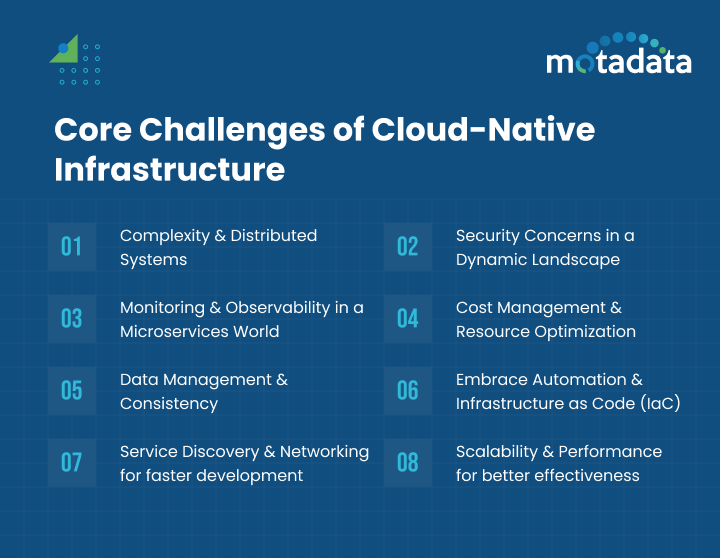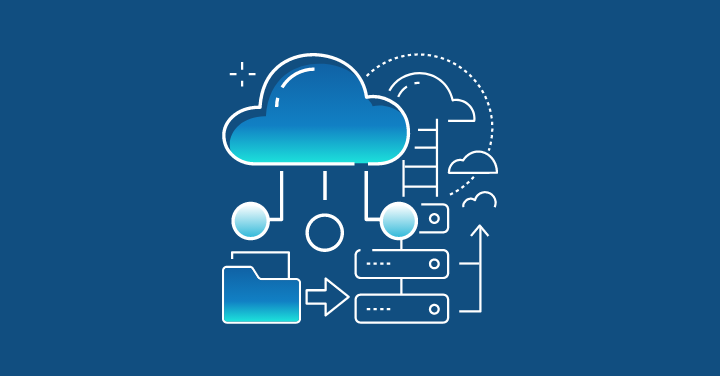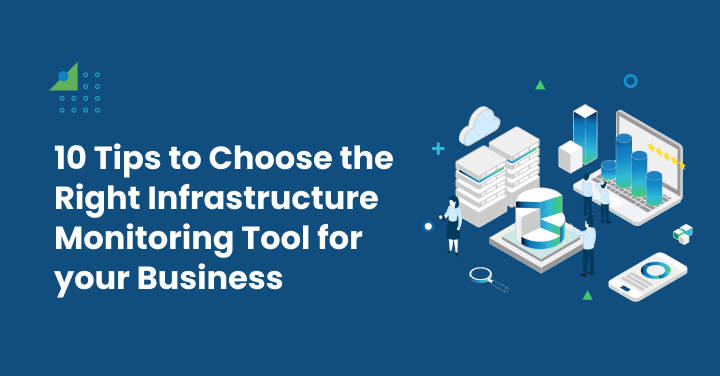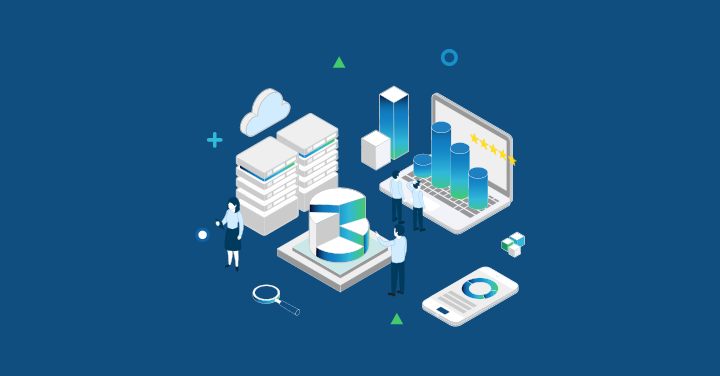Cloud-native infrastructure has completely transformed the way businesses operate today.
The adoption of this new practice has made it simple for organizations to deploy and manage their applications.
In fact, according to a report by the Cloud Native Computing Foundation (CNCF), more than 6.8 million cloud-native developers are already using this architecture.
Microservices, containers, and DevOps techniques are the core principles of cloud-native infrastructure.
They enable quick deployments and scalability and help improve the overall efficiency and quality of the software development lifecycle.
With cloud-native adoption, developers can build highly scalable applications, save on maintenance of physical infrastructure, and ensure full-time availability.
There are several benefits to cloud infrastructure, but it also comes with numerous challenges.
Let us discuss some common challenges with cloud-native infrastructure in detail.
Core Challenges of Cloud-Native Infrastructure
Having a cloud-native infrastructure is essential for enterprises looking to fully utilize cloud computing.
This modern approach uses containerization, microservices, and continuous delivery to create and manage scalable systems in dynamic environments.
There are several benefits to adopting this approach; however, for successful cloud services, it is essential to identify its challenges.
Nevertheless, there are a number of important challenges to overcome while implementing and maintaining cloud-native infrastructure.
Security, compliance, scalability, performance, cost control, and operational complexity are just a few of the many areas in which these challenges occur.
We have covered all these areas in detail and a few more to make it easier for you.
Here are a few core challenges that enterprises must know to ensure the smooth operation of cloud-native technology and help them accomplish their digital transformation objectives quickly.
1. Complexity and Distributed Systems
One of the biggest challenges of cloud-native infrastructure is its complex and distributed environment.
Several APIs, containers, microservices, service mesh, and immutable infrastructure are spread across the diverse cloud-native architecture.
Your organization cannot keep track of all the components without the right tools.
Also, maintaining consistency and proper communication between all the components can be quite challenging for organizations.
Despite its distributed systems, it is essential for professionals to track and maintain the availability, performance, and security of cloud-native applications for a better user experience.
However, the IT and engineering teams cannot achieve this goal without a comprehensive understanding of the components, cloud architecture, and supported technologies.
These all together help provide intelligent insights and fix issues before they impact user experience.
Furthermore, the Cloud’s dynamic nature makes it a more complex platform, so organizations must invest in robust infrastructure monitoring solutions that offer clear visibility into the entire system and enable quick resolution.
Solution:
Implement Service Mesh: Istio and Linkerd are a few service mesh technologies you can incorporate to ease the communication between microservices.
Further, implementing these technologies in the native services enables better security and visibility into the different metrics, logs, and tracing.
With service mesh, businesses can monitor the health and performance of complex microservices in real time.
Container Orchestration: Use Kubernetes to the maximum extent possible to automate the deployment, scaling, and efficient management of all applications that run in containers, regardless of their complexity.
2. Security Concerns in a Dynamic Landscape
Another major challenge for cloud-based infrastructure is its security and compliance.
The digital world is constantly evolving, and people are adopting new technologies and methods to ease the whole process, but these are also increasing the risk of being attacked.
Cloud has a distributed architecture and uses several open-source tools that automatically increase the attack surface.
You can’t change an attacker’s mindset, but you can protect your data at all times by implementing robust security practices.
Regular security audits and ensuring compliance with industry best practices can help keep your cloud-native environment secure.
Several other practices can also help identify and address security risks in real time.
Some businesses even find security challenges in containerized applications.
Additionally, managing access controls across different environments is another challenge.
Hence, ensure that your organization implements comprehensive security measures to enhance the security system and mitigate risks.
Solution:
Zero Trust Security Model: By adopting the zero trust security model, businesses can stay assured that no unauthorized user can enter or access the system and their crucial data.
Under this model, regular checking and scanning are performed to prevent unauthorized access.
Regular Security Audits: Another appropriate solution to safeguard your data is to run routine audits for your networks and cloud servers.
Regular security audits will help identify the weak spots or potential security risks in real time.
Further, you can prevent problems from escalating and keep your systems secure.
3. Monitoring and Observability in a Microservices World
Cloud environments include microservices, containerized applications, and serverless functionalities that produce a large amount of data. Monitoring this much data can be challenging and hectic.
A single microservice runs on 100 machines and 100 microservices together can run on a single device. So, you can imagine how much data is produced by microservices alone.
Traditional monitoring practices won’t be enough to provide a holistic view of distributed systems with ephemeral components.
You would need observability tools that go beyond traditional monitoring and provide in-depth insights into the internal state of the three pillars, i.e., logs, metrics, and traces.
In short, to track the IT infrastructure and its key components, you would require a comprehensive monitoring system that offers end-to-end visibility, performance tracking functionalities, anomaly detection, and troubleshooting real-time issues.
Some of the popular monitoring tools available in the market include Motadata, Prometheus, and more.
Solution:
Comprehensive Observability Tools: To monitor all internal and security systems closely, it is best to invest in observability tools like Prometheus, Grafana, or Jaeger. These tools can provide clear visibility and accurate insights into logs, metrics, and traces.
Health Checks and Alerts: Configure alert systems that notify in real-time, to monitor the complex cloud environment and stay current on incoming threats and risks. Further, invest in monitoring tools that run regular health checks and automatically respond to detected issues.
4. Cost Management and Resource Optimization
Cost management is also a big challenge in cloud environments. The pay-as-you-go model offers more flexibility, but it also opens doors for hidden costs and inefficient resource allocation.
Underutilized resources or over-provisioned infrastructure may result in unnecessary costs.
Organizations must optimize the cost management system in native infrastructure.
You can do this by monitoring infrastructure components, resource usage, leveraging serverless computing and containerized technologies, cost comparison, and more.
You must incorporate a proactive approach and implement tools that help track usage patterns across different systems and provide appropriate recommendations for cost savings.
Further ensures that the tool can monitor performance, identify anomalies, and troubleshoot issues in real-time for accurate decisions. It is also important to understand the pricing model for each workload.
A number of services are provided by some cloud providers to assist businesses in saving money, but the expenses can mount up quickly.
Teams may also need to be aware of any additional expenses that may be incurred by their cloud deployments.
Several cost management tools are available in the market that can ease this challenge and provide deep insights for better cost optimization.
Solution:
Resource Utilization Analytics: Implementing these analytics will allow IT teams to gain clear visibility into resource usage. It will make it easier to track underused or overutilized resources, which can then be used to find ways to optimize them and ensure no waste. This will eventually help save on operational costs.
Right-Sizing and Auto-Scaling: With right-sizing and auto-scaling techniques, businesses can adjust resources based on demand and eliminate additional expenses. Thus, they can ensure cost efficiency by only utilizing the necessary resources.
5. Data Management and Consistency
Another big task is maintaining data consistency across different platforms and cloud environments located at several geographical locations. No matter where the user has sent a request, data must be properly synchronized and consistent.
Ensuring consistency is advantageous from the user’s perspective and guarantees the integrity and reliability of cloud applications.
Compliance management and data governance are other critical factors that one must consider. Organizations need to ensure that their data is properly managed in accordance with industry and regulatory standards.
This may include proper data encryption, audits, and access control functionalities.
The best way to overcome these challenges is to invest in data management tools that offer highly advanced features such as synchronization, automated backups, and more.
Alongside these tools, applying native architecture patterns such as Microservices, Sidecar, or Strangler helps structure applications for easier scaling, deployment, and service communication.
Since, in a cloud environment, your data can be stored in a private, public, or hybrid cloud, make sure to implement a strategy that supports data portability and interoperability features.
Solution:
Data Replication and Synchronization: With these mechanisms, businesses ensure they have a duplicate copy of their data available in different regions for use anytime and anywhere. Thus, the systems run smoothly with minimum downtime.
Data Governance Frameworks: By establishing these frameworks, businesses can ensure the delivery of accurate and high-quality data at all times, as well as maintain compliance with laws and regulations.
6. Embrace Automation and Infrastructure as Code (IaC)
Automation is the foundation of the native technologies that play a key role in ensuring consistency and operational efficiency.
Automating the application deployments, infrastructure provisioning, and configuration management lowers the risk of human errors and boosts greater efficiency.
Further, the concept of infrastructure as code (IaC) makes it easy for software developers and the entire development teams to easily manage infrastructure through code and enable version control.
Automated testing, integration, and deployment procedures in continuous integration and delivery (CI/CD) pipelines accelerate the distribution of new features and updates.
By incorporating automation into all phases of the development and deployment lifecycle, organizations can increase their agility and responsiveness.
Solution:
IaC Tools: There are several tools like Terraform, Ansible, Pulumi, and CloudFormation, your organization can rely on to codify their infrastructure, manage running applications, and manage resources across various cloud environments.
It further reduces manual interventions, streamlines the application development process, and improves reliability.
CI/CD Pipelines: To automate the deployment processes, you can implement CI/CD pipelines using various tools like Jenkins, GitLab CI, or CircleCI.
7. Service Discovery and Networking for faster development
With cloud services, it is quite challenging to keep track of all services, networks, and how each component communicates with one another.
The microservices architecture is complex, and inter-service communication without the right tools and methods may result in delays.
To add more success, businesses grow and scale on a constant basis. In such a case, efficiently managing communication and network policies in a microservices architecture is difficult.
Solution:
Network Policies: It is best to use Kubernetes Network policies or other tools like Calico to control and regulate the traffic.
With these policies in practice, you can ensure that all your communication between different services is highly secure.
DNS-Based Service Discovery: Kubernetes and other tools like Consul have built-in service discovery features that ease the process of finding services.
Using these mechanisms, you can discover and connect with services even without having the exact address.
8. Scalability and Performance for better effectiveness
Another challenge that most businesses face when using cloud services is achieving optimal performance while scaling applications.
It is quite difficult to ensure premium service delivery at all times without compromising or causing downtime.
Several components play a key role in service delivery, and even a minor fault or error can stop you from achieving optimal performance.
Hence, proper management of resource utilization, load balancing, and efficient scaling of applications are the areas of major concern that one must take into account.
Solution:
Load Balancing: Several tools, like Motadata, are available in the market for load balancing. These Tools automatically distribute your incoming traffic among several servers for smooth operations, ensuring there is no overloading on a single server.
Optimized Database Access: The best way to ensure smooth operations during peak hours or with scaling applications is to optimize your database queries or use database connection pooling to reduce the overhead of creating new connections.
For optimal read traffic distribution and latency reduction, deploy read replicas in areas or data centers nearer to the users.
Conclusion
Cloud computing offers several benefits to organizations, such as improved scalability, efficiency, agility, and faster deployment of cloud-native applications.
But at the same time, it also offers various challenges that can impact performance if not in a timely handled.
Since the cloud is distributed and complex, you may face challenges in maintaining consistency and communication.
Further, attackers are always on the move, and maintaining cloud-native security is another challenge.
Microservices architecture is also complex and requires constant monitoring to troubleshoot issues.
Cost management, data management, and automation can also be challenging for business systems.
Despite these challenges, it is one of the best practices for modern enterprises.
By implementing best practices, infrastructure management, and proactive strategies, you can overcome the above-mentioned challenges and harness the full potential of cloud-native infrastructure and greater efficiency.
FAQs
Cloud-native infrastructure is an approach to building, designing, deploying, and handling all applications distributed across the cloud environment. In order to build highly scalable, fast, flexible, and resilient applications, businesses use modern tools that leverage containers, microservices, and DevOps practices.
This approach helps break down modern applications into small, manageable components that can be deployed and scaled much more easily.
Organizations can benefit from cloud-native software applications in the following ways:
Ensures high availability: Businesses may create robust and highly accessible apps using this approach. Further, companies can increase app resources during peak seasons to give customers a better experience, and feature updates that prevent downtime.
Cost Reduction: By adopting this practice, organizations no longer have to worry about procurement and maintenance costs of physical infrastructure. As a result, they can save a lot on operational expenses.
Increase efficiency: Cloud-native development brings about continuous delivery (CD) and other agile approaches like DevOps. Thanks to automated cloud technologies, native apps, cloud services, and modern design culture, developers can quickly create scalable applications.
By investing in advanced infrastructure monitoring tools, users can gain clear visibility into each microservice and container’s health, availability, and performance. Further, incorporating an observability framework will allow IT teams to track the applications’ internal state, identify the anomalies’ root cause, and troubleshoot issues before they impact your performance or health status.
There are several cost optimization and management tools available in the market, for example, Microsoft Azure Cost Management, Google Cloud’s cost management suite, or AWS Cost Explorer, that can help you optimize your cloud costs.
It is essential to track the resource utilization and patterns to work on the expenses and manage them. This cannot be done with manual labor, and however, if you invest in the above-mentioned tools, you can identify underutilized resources and patterns much more easily.
Further, these tools provide recommendations on how to optimize cost and insights into expenses. So, leverage these tools to optimize your cloud costs for your cloud-native infrastructure.








